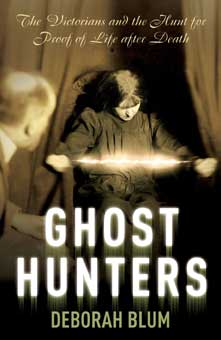The Victorians were possessed by spirits. At a time when Darwin had shaken the foundations of religious belief and the notion of “progress” had spurred an unprecedented materialist boom, more and more people were fascinated by the supernatural – and especially the question of whether there was, after all, life after death. The hunt was on for scientific proof of those phenomena that seemed to be emanations from another world: ghosts, poltergeists, apparitions, telepathy, ouija boards and conversations through mediums with the dead.
 Those seeking answers immediately ran into difficulties, however. For a start, serious scientists would hear none of it. Having themselves braved the wrath of the religious establishment for embracing Darwinism and admitting no concept that was not grounded in material proof, they were deeply hostile to any of their number who dabbled in the mystic or who proposed an investigation into spiritualism. Scientific journals in Britain and America shunned papers published on the subject. Those studying the workings of the mind – forerunners of psychologists – were denounced by all sides: by professional bodies which mocked their naiveté, and by those caught in the thrall of spiritualism, who were furious at the exposure of many psychic phenomena as tricks, frauds and the work of charlatans.
Those seeking answers immediately ran into difficulties, however. For a start, serious scientists would hear none of it. Having themselves braved the wrath of the religious establishment for embracing Darwinism and admitting no concept that was not grounded in material proof, they were deeply hostile to any of their number who dabbled in the mystic or who proposed an investigation into spiritualism. Scientific journals in Britain and America shunned papers published on the subject. Those studying the workings of the mind – forerunners of psychologists – were denounced by all sides: by professional bodies which mocked their naiveté, and by those caught in the thrall of spiritualism, who were furious at the exposure of many psychic phenomena as tricks, frauds and the work of charlatans.
Many prominent figures were caught up in the controversy. Arthur Conan Doyle, the creator of Sherlock Holmes, was famously intrigued. So too were Mark Twain, Arthur Balfour, the future Prime Minister, John Ruskin, Lewis Carroll, Leslie Stephen the father of Virginia Woolf, the sister of Rudyard Kipling and Marie Curie in France. The poet Robert Browning was also drawn in, but only to ridicule “Mr Sludge”, a caricature of Daniel Dunglas Home, one of the many famous frauds.
There were also many with distinguished academic reputations who were nevertheless fascinated. One of the most dogged was William James, the brother of the American writer Henry James. His fellow ghost-hunters included Darwin’s co-discoverer of the theory of evolution, a French physiologist who would win the Nobel prize for medicine, an Australian who became a founding member of the American Anthropological Society, a female mathematician who became principal of the first Cambridge college for women, a pioneer in British utilitarian philosophy and a trio of respected physicists. Even Michael Faraday, one of the most gifted of all 19th-century scientists, admitted in a letter to The Times that he had performed laboratory tests to investigate the medium’s “talking table”. He found nothing but superstition – the board moved, he said, during a séance owing to “mere mechanical pressure exerted inadvertently by the turner”.
Those sure there was more than mere superstition were constantly disappointed. Despite dozens of claims, painstakingly collected, of sceptics astonished by a medium’s uncanny ability to reveal details of distant relatives or to pass on messages from people hundreds of miles away who unexpectedly died minutes later, psychic researchers found it almost impossible to rule out trickery and coincidence. Some of the frauds were laughably blatant. One of the most famous was the notorious Madame Blavatsky, a Russian living in India who had founded the Theosophical Society in New York and attracted a wide following. Her psychic powers were found partly to depend on her getting hold of letters, by bribery or otherwise, steaming them open, reading them and resealing them. In her shrine, one researcher persuaded the servants to reveal that she had a set of double-sided drawers that opened into a chamber behind a gold facade that was her bedroom, where she read letters that they passed through. The Society for Psychical Research, which first convened in 1882, concluded that she was neither the mouthpiece of seers nor a vulgar adventuress but “one of the most accomplished and interesting imposters in history”.
Other mediums used hidden wires or collapsible rods to make things move. Some replaced blank slates during a séance with those pre-inscribed with a spirit message. Some darkened the lights so that they could produce fine muslin fabric concealed in their underwear to fake “full-form materialisation”. Each fraud brought ridicule on the weary researchers and eventually the American branch of the society was obliged to disband under the scorn of scientific opinion.
But William James had colleagues willing to carry on. The writer Henry Sidgwick, a respected classics don at Trinity, Cambridge, spent years tracking down spiritualist phenomena. So did his wife Nora, although she had a full-time job as principal of Newnham College. Frederick Myers and Edmund Gurney persisted through thick and thin, exhausting themselves and, in Gurney’s case, almost breaking up his family. There must be something there, they insisted. They recruited volunteers to compile a Census of Hallucinations. They sent in papers to the Metaphysical Society or lobbied international congresses. In vain.
They were sometimes ahead of their time. The church wanted nothing to do with spiritualism, which it saw as akin to devil-worship; the Darwinists believed any such research discredited the new rationalism which was attempting to establish its monopoly in science. But the researchers came up with terms and hypotheses such as telepathy or psychometry (the belief that a spiritual trace of an event could be left in a building or on an object) that do not provoke such ridicule nowadays. Modern psychology has discovered much about auto-suggestion, hypnosis, the subliminal and the subconscious that was unknown to the pre-Freudian world.
Deborah Blum’s account, in Ghost Hunters, of their dogged investigations, their failures and their occasional stupidity is wonderfully entertaining – full of anecdotes, snatches of correspondence, weird detail and moving accounts of the disappointments and personal tragedies that overtook many of them. What gives her book edge and authority is her helpful depiction of the mental atmosphere of Victorian England – and America: societies caught between belief and disbelief, shaken by change and unable to reconcile new ideas with old doctrine. The psychical researchers saw their goal as bridging research and religion, to show that they were not incompatible and that one could even help explain the other.
Blum does not come down on either side. She does not attempt to explain the one medium whom no one was able to fault – the American Leonora Piper, who allowed herself to be put through excruciating tests but still demonstrated inexplicable evidence of telepathy, premonitions and communication from the deceased. The ghost-hunters never established a creditable science, but they have left a corpus of work that still fascinates today’s more sceptical age. Who will ever know what might lie on the other side? ■
Ghost Hunters is published by Century

